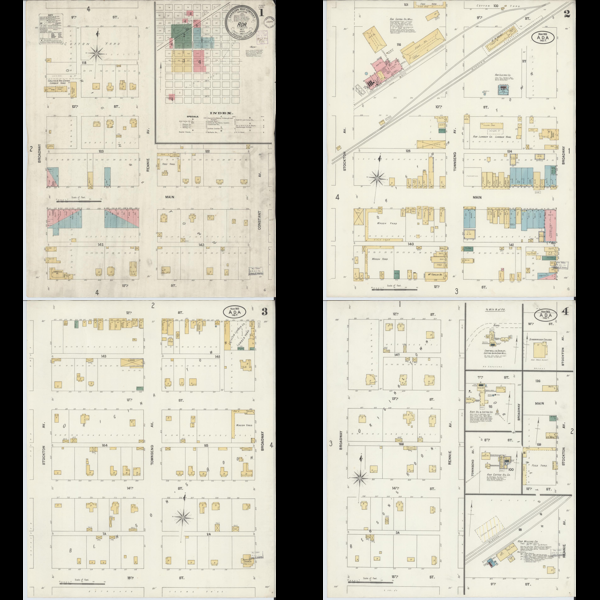LoC Data Package Tutorial: Sanborn Maps collection#
This notebook will demonstrate basic usage of using Python for interacting with data packages from the Library of Congress via the Sanborn Maps data package which is derived from the Library’s Sanborn Maps collection. We will:
Prerequisites#
In order to run this notebook, please follow the instructions listed in this directory’s README.
Output data package summary#
First, we will select Sanborn Maps data package and output a summary of it’s contents
import io
import json
import math
import boto3 # for interacting with Amazon S3 (where the data is stored)
import pandas as pd # for reading, manipulating, and displaying data
from helpers import get_s3_bucket_stats
BUCKET_NAME = 'loc-sanborn-maps' # The name of public S3 bucket
# Connect to Amazon S3
s3 = boto3.client('s3')
stats = get_s3_bucket_stats(s3, BUCKET_NAME)
# Convert to Pandas DataFrame and show table
pd.DataFrame(stats)
| FileType | Count | Size | |
|---|---|---|---|
| 0 | .jpg | 440,819 | 148.79GB |
| 1 | .zip | 76 | 146.45GB |
| 2 | .json | 122 | 436MB |
| 3 | .html | 65 | 425MB |
| 4 | .txt | 61 | 202MB |
| 5 | .jsonl | 60 | 172MB |
| 6 | .csv | 65 | 123MB |
| 7 | .png | 3 | 198KB |
| 8 | 1 | 42KB | |
| 9 | .md | 1 | 35KB |
Query the metadata in a data package#
Next we will download a data package’s metadata, print a summary of the items’ State values, then filter by a particular State.
All data packages have a metadata file in .json and .csv formats. Let’s load the data package’s metadata.json file:
obj = s3.get_object(Bucket=BUCKET_NAME, Key=f'metadata.json')
contents = obj.get('Body', '[]').read() # Read contents as a string
data = json.loads(contents) # Parse string as JSON
print(f'Loaded metadata file with {len(data):,} entries.')
Loaded metadata file with 50,600 entries.
Next let’s convert to pandas DataFrame and print the available properties
df = pd.DataFrame(data)
print(', '.join(df.columns.to_list()))
Date, Digitized, Id, IIIF_manifest, Language, Last_updated_in_api, Location_text, City_text, County_text, State_text, Country_text, Location_secondary_text, Mime_type, Notes, Number_of_files, Online_format, Original_format, Part_of, Preview_url, Repository, Source_collection, Subject_headings, Title, Type_of_resource, Location
Next print the top 10 most frequent States in this dataset
# Since "State_text" is a list, we must "explode" it so there's just one state per row
# We convert to DataFrame so it displays as a table
df['State_text'].explode().value_counts().iloc[:10].to_frame()
| count | |
|---|---|
| State_text | |
| New York | 3693 |
| Pennsylvania | 3056 |
| Illinois | 2878 |
| California | 2641 |
| Ohio | 2412 |
| Texas | 2238 |
| Michigan | 1962 |
| Indiana | 1709 |
| Oklahoma | 1707 |
| Missouri | 1700 |
Now we filter the results to only those items with State “Oklahoma”
df_by_state = df.explode('State_text')
subset = df_by_state[df_by_state.State_text == 'Oklahoma']
print(f'Found {subset.shape[0]:,} items with state "Oklahoma"')
Found 1,707 items with state "Oklahoma"
Download and display images#
Finally we will download and display the images associated with the first item in the Oklahoma subset.
First, we download the file manifest to retrieve the image filenames associated with the records
obj = s3.get_object(Bucket=BUCKET_NAME, Key=f'manifest.json')
contents = obj.get('Body', '[]').read() # Read contents as a string
data = json.loads(contents) # Parse string as JSON
files = [dict(zip(data["cols"], row)) for row in data["rows"]] # zip columns and rows
print(f'Loaded manifest file with {len(files):,} entries.')
Loaded manifest file with 607,892 entries.
Next we will retrieve the image filenames associated with the first record in our subset.
item = subset.iloc[0]
item_id = item["Id"]
item_image_files = [file for file in files if file["item_id"] == item_id]
found_count = len(item_image_files)
print(f"Found {found_count:,} image files for {item_id}")
Found 4 image files for http://www.loc.gov/item/sanborn06968_001/
Finally, let’s output the first four images as a grid
from IPython.display import display # for displaying images
from PIL import Image # for creating, reading, and manipulating images
# Define image dimensions
image_w = 600
image_h = 600
cols = math.ceil(found_count / 2.0)
rows = math.ceil(found_count / 2.0)
cell_w = image_w / cols
cell_h = image_h / rows
# Create base image
base_image = Image.new("RGB", (image_w, image_h))
# Loop through image URLs
for i, file in enumerate(item_image_files):
# Downoad the image to memory
obj = s3.get_object(Bucket=BUCKET_NAME, Key=f'maps-by-state/{file["filename"]}')
image_filestream = io.BytesIO(obj.get('Body').read())
# And read the image data
im = Image.open(image_filestream)
# Resize it as a thumbnail
im.thumbnail((cell_w, cell_h))
tw, th = im.size
# Position it
col = i % cols
row = int(i / cols)
offset_x = int((cell_w - tw) * 0.5) if tw < cell_w else 0
offset_y = int((cell_h - th) * 0.5) if th < cell_h else 0
x = int(col * cell_w + offset_x)
y = int(row * cell_h + offset_y)
# Paste it
base_image.paste(im, (x, y))
# Display the result
display(base_image)
